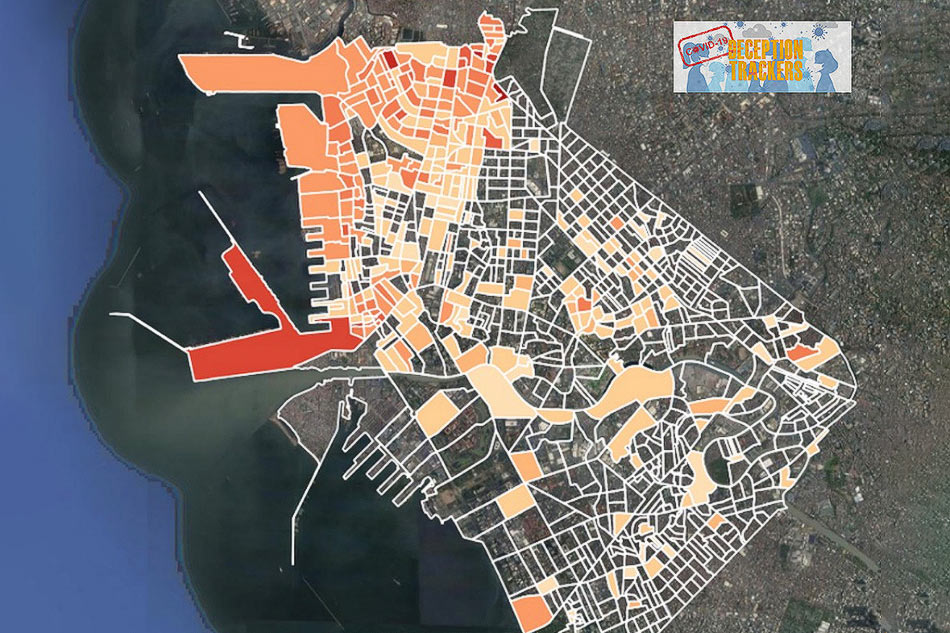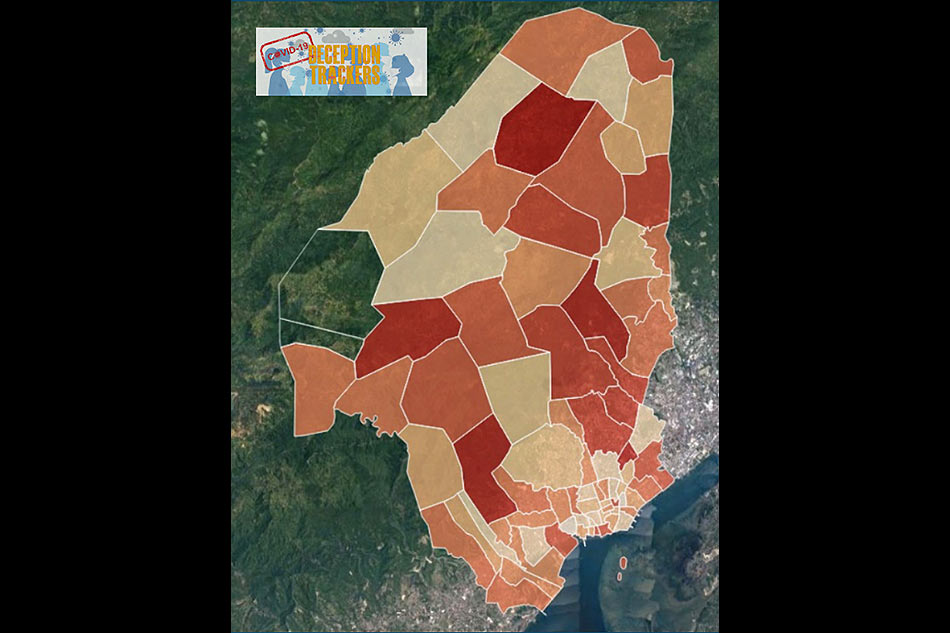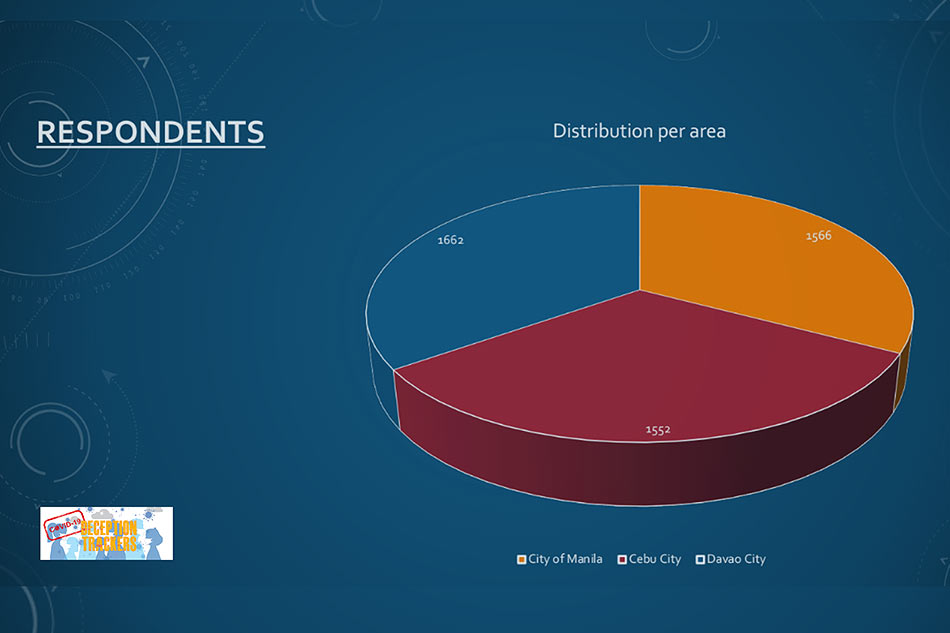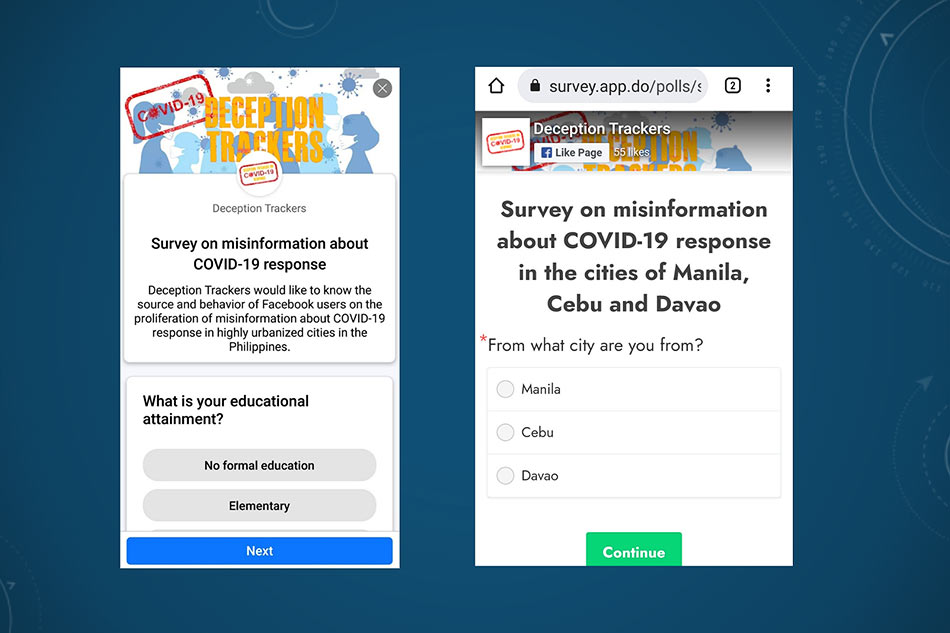'Marites' in your area: Mapping COVID-19 fake news sources in Metro Manila, Cebu, Davao | ABS-CBN
ADVERTISEMENT
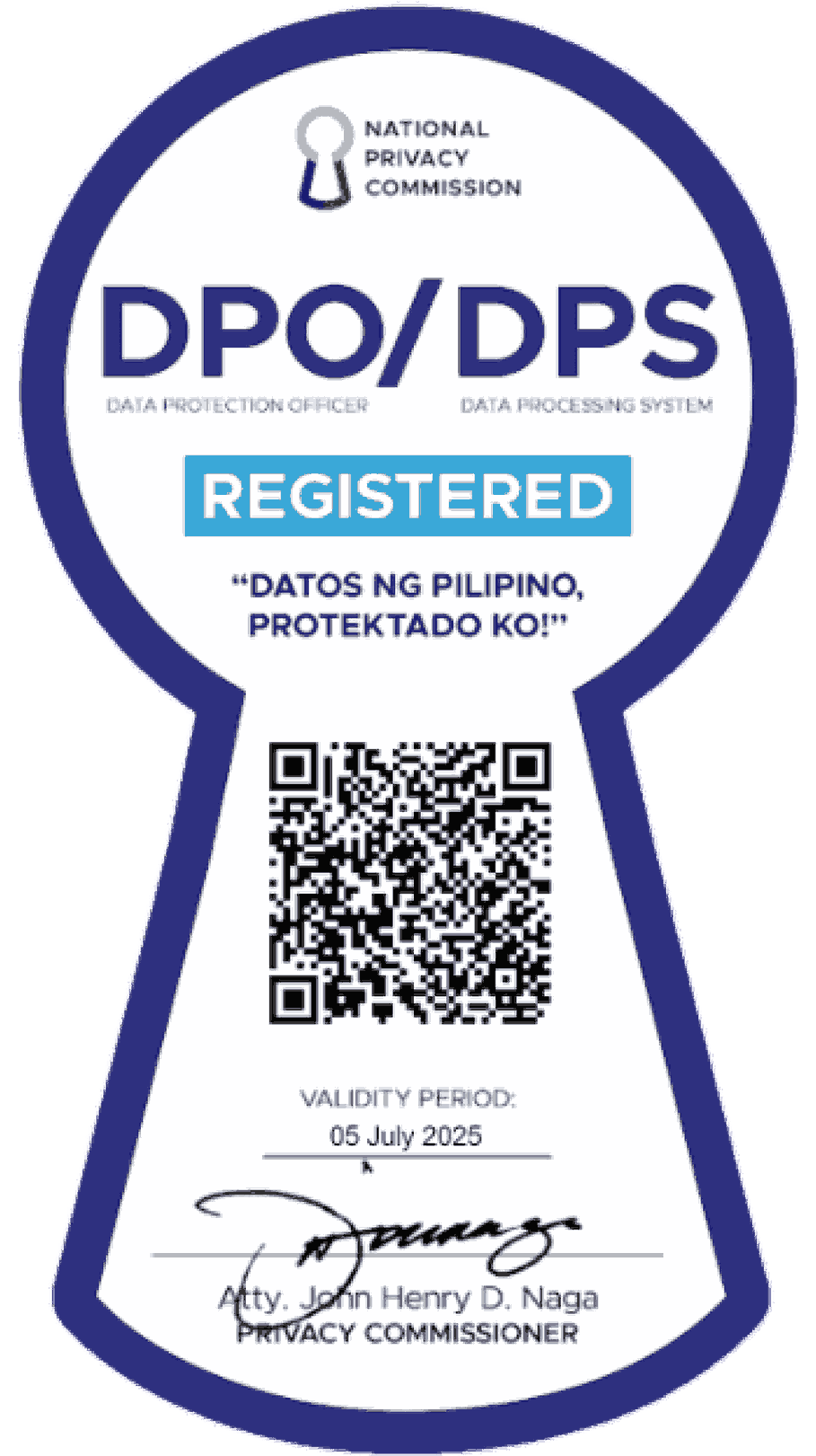
Welcome, Kapamilya! We use cookies to improve your browsing experience. Continuing to use this site means you agree to our use of cookies. Tell me more!
'Marites' in your area: Mapping COVID-19 fake news sources in Metro Manila, Cebu, Davao
'Marites' in your area: Mapping COVID-19 fake news sources in Metro Manila, Cebu, Davao
Rosy Mina
Published Nov 09, 2022 06:37 PM PHT
False, hindi totoo (not true), no basis, erroneous – these are the usual labels that befall a fake news item when it is fact-checked. But where did it come from, who spread it, and is it possible to be amidst so-called misinformation hotspots?
False, hindi totoo (not true), no basis, erroneous – these are the usual labels that befall a fake news item when it is fact-checked. But where did it come from, who spread it, and is it possible to be amidst so-called misinformation hotspots?
These questions were asked by a Filipino research project team during TechCamp Malaysia 2020, a virtual media literacy program spearheaded by Penang Institute (PI) and the United States Embassy in Kuala Lumpur, Malaysia.
These questions were asked by a Filipino research project team during TechCamp Malaysia 2020, a virtual media literacy program spearheaded by Penang Institute (PI) and the United States Embassy in Kuala Lumpur, Malaysia.
Called the Deception Trackers, the team composed of Jorge Golle, Jesusa Estanislao, and this writer sought to track and map COVID-19 misinformation sources in hopes of doing something more about fake news than just correcting it.
Called the Deception Trackers, the team composed of Jorge Golle, Jesusa Estanislao, and this writer sought to track and map COVID-19 misinformation sources in hopes of doing something more about fake news than just correcting it.
For purposes of the project, misinformation was the chosen term to denote fake news instead of disinformation because the intention of a source was difficult to determine, and its location was the main concern.
For purposes of the project, misinformation was the chosen term to denote fake news instead of disinformation because the intention of a source was difficult to determine, and its location was the main concern.
ADVERTISEMENT
Due to limitations in scope, Facebook was the only social media platform considered and three highly urbanized Philippine cities with high Facebook usage were chosen as areas of focus: Manila, Cebu, and Davao.
Due to limitations in scope, Facebook was the only social media platform considered and three highly urbanized Philippine cities with high Facebook usage were chosen as areas of focus: Manila, Cebu, and Davao.
With the proposal to track COVID-19 fake news sources and map supposed misinformation hotspots, the research project was approved and funded by the TechCamp Malaysia Small Grant Initiative.
With the proposal to track COVID-19 fake news sources and map supposed misinformation hotspots, the research project was approved and funded by the TechCamp Malaysia Small Grant Initiative.
“As the tagline of TechCamp Malaysia 2020 says ‘Building Trust and Media Literacy in the Digital Age’, this project serves the purpose in understanding and analyzing sources of fake news on a social media digital platform,” TechCamp Malaysia 2020 liaison officer Zhi Xian Tan of PI told ABS-CBN News.
“As the tagline of TechCamp Malaysia 2020 says ‘Building Trust and Media Literacy in the Digital Age’, this project serves the purpose in understanding and analyzing sources of fake news on a social media digital platform,” TechCamp Malaysia 2020 liaison officer Zhi Xian Tan of PI told ABS-CBN News.
“The objectives of TechCamp Malaysia is to counteract disinformation as well as build upon prior public, private, and civil society activities concerning the topic of countering disinformation in Southeast Asia. We are glad to see that Deception Trackers was identifying the sources of fake information spread across highly urbanized cities in the Philippines.”
“The objectives of TechCamp Malaysia is to counteract disinformation as well as build upon prior public, private, and civil society activities concerning the topic of countering disinformation in Southeast Asia. We are glad to see that Deception Trackers was identifying the sources of fake information spread across highly urbanized cities in the Philippines.”
USING GEOSPATIAL DATA TO KNOW MORE ABOUT FAKE NEWS SOURCES
As the pandemic intensified since 2020, so did the infodemic – the widespread proliferation of misinformation during a disease outbreak such as the novel coronavirus that greatly gripped the world.
As the pandemic intensified since 2020, so did the infodemic – the widespread proliferation of misinformation during a disease outbreak such as the novel coronavirus that greatly gripped the world.
At least 21,018 fake news items on the pandemic were fact-checked as of October 16, 2022 by the #CoronaVirusFacts Alliance of more than 100 fact checkers worldwide, led by the Poynter Institute’s International Fact-Checking Network.
At least 21,018 fake news items on the pandemic were fact-checked as of October 16, 2022 by the #CoronaVirusFacts Alliance of more than 100 fact checkers worldwide, led by the Poynter Institute’s International Fact-Checking Network.
But why the need to dig deep and determine the location of the “misinformation disease” carriers, locally regarded as “Marites,” a slang for rumormongers that include misinformation peddlers?
But why the need to dig deep and determine the location of the “misinformation disease” carriers, locally regarded as “Marites,” a slang for rumormongers that include misinformation peddlers?
“The research took place at the right time when COVID-19 hit the world. It was one of the times when the amount of fake news is the largest across social media and communication platforms,” noted Tan, who earned a Commonwealth Executive MBA from Wawasan Open University.
“The research took place at the right time when COVID-19 hit the world. It was one of the times when the amount of fake news is the largest across social media and communication platforms,” noted Tan, who earned a Commonwealth Executive MBA from Wawasan Open University.
The use of geospatial information was incorporated to bring forth a new approach in dealing with fake news sources.
The use of geospatial information was incorporated to bring forth a new approach in dealing with fake news sources.
Hence, the project title was “Tracking the proliferation of false information on Facebook related to pandemic responses in highly urbanized cities in the Philippines.”
Hence, the project title was “Tracking the proliferation of false information on Facebook related to pandemic responses in highly urbanized cities in the Philippines.”
Mapping no longer deals with just geographical points, and this was mentioned to the author in a Mongabay.com article by then Philippine Institute of Volcanology and Seismology (Phivolcs) head and Department of Science and Technology (DOST) Undersecretary Dr. Renato Solidum, Jr.
Mapping no longer deals with just geographical points, and this was mentioned to the author in a Mongabay.com article by then Philippine Institute of Volcanology and Seismology (Phivolcs) head and Department of Science and Technology (DOST) Undersecretary Dr. Renato Solidum, Jr.
“The traditional way of looking at data or statistics is by the table. But now, the trend is for every point on the ground, you can put any statistical information relative to that point,” said Solidum, now the DOST Secretary, in relation to the web and mobile application GeoMapperPH that was developed by government agencies led by Phivolcs.
“The traditional way of looking at data or statistics is by the table. But now, the trend is for every point on the ground, you can put any statistical information relative to that point,” said Solidum, now the DOST Secretary, in relation to the web and mobile application GeoMapperPH that was developed by government agencies led by Phivolcs.
Solidum added that a geospatial database created by GeoMapperPH can feature location points with quantitative (measurements of areas and perimeters) and qualitative (structural age, building materials, ground soil type, and population) details.
Solidum added that a geospatial database created by GeoMapperPH can feature location points with quantitative (measurements of areas and perimeters) and qualitative (structural age, building materials, ground soil type, and population) details.
For the Deception Trackers’ visualization maps, the location points referred to the barangay (village or community) or city (if the barangay is not known) of the fake news sources as provided by the respondents.
For the Deception Trackers’ visualization maps, the location points referred to the barangay (village or community) or city (if the barangay is not known) of the fake news sources as provided by the respondents.
Each location point can also be mapped in terms of the other answers given: the misinformation topic encountered, form of misinformation (image, video, text post, or website link), and relation to the source (partner/spouse, sibling, neighbor, officemate, schoolmate/classmate, friend, relative, and unknown).
Each location point can also be mapped in terms of the other answers given: the misinformation topic encountered, form of misinformation (image, video, text post, or website link), and relation to the source (partner/spouse, sibling, neighbor, officemate, schoolmate/classmate, friend, relative, and unknown).
Another proposed visualization to spotlight the proliferation of COVID-19 misinformation would involve lines emanating from the location points of fake news sources to the location points of their respective fake news victims.
Another proposed visualization to spotlight the proliferation of COVID-19 misinformation would involve lines emanating from the location points of fake news sources to the location points of their respective fake news victims.
“By harnessing location-based data, the Deception Trackers sought to map out the findings to help craft targeted solutions to the pandemic infodemic,” the group said in a blog post on TechCampMalaysia.com.
“By harnessing location-based data, the Deception Trackers sought to map out the findings to help craft targeted solutions to the pandemic infodemic,” the group said in a blog post on TechCampMalaysia.com.
TOP 10 'MISINFORMATION HOTSPOTS'
In 2021, the group conducted a targeted survey on Facebook Philippines on COVID-19 misinformation in the cities of Manila, Cebu, and Davao with a 5% margin of error.
In 2021, the group conducted a targeted survey on Facebook Philippines on COVID-19 misinformation in the cities of Manila, Cebu, and Davao with a 5% margin of error.
The survey met the target number of 4,941 respondents, with 4,780 being able to answer all questions while 161 did not.
The survey met the target number of 4,941 respondents, with 4,780 being able to answer all questions while 161 did not.
The distribution of respondents tallied 1,566 in Manila, 1,552 in Cebu City, and 1,662 in Davao City.
The distribution of respondents tallied 1,566 in Manila, 1,552 in Cebu City, and 1,662 in Davao City.
Aside from the sources and types of misinformation encountered, the respondents were asked about their full name, date of birth, gender, e-mail address, street address, educational attainment, occupation, reactions to the fake news item, and recommendations on how to counter the surge of misinformation on Facebook and other social media platforms.
Aside from the sources and types of misinformation encountered, the respondents were asked about their full name, date of birth, gender, e-mail address, street address, educational attainment, occupation, reactions to the fake news item, and recommendations on how to counter the surge of misinformation on Facebook and other social media platforms.
The information gathered, protected with confidentiality, was processed with data experts involved.
The information gathered, protected with confidentiality, was processed with data experts involved.
After which, the places that emerged as locations of fake news sources were mapped out accordingly.
After which, the places that emerged as locations of fake news sources were mapped out accordingly.
Based on the answers of respondents from Manila, the top locations of misinformation sources in Manila and neighboring areas were:
Based on the answers of respondents from Manila, the top locations of misinformation sources in Manila and neighboring areas were:
- Quezon City
- Makati
- Barangay 208
- Malabon
- Taguig
- Pasig
- Antipolo, San Juan, Barangay 146, Mandaluyong
- Valenzuela, Marikina
- Navotas, Caloocan, Pasay, Muntinlupa
- Barangay 195
- Quezon City
- Makati
- Barangay 208
- Malabon
- Taguig
- Pasig
- Antipolo, San Juan, Barangay 146, Mandaluyong
- Valenzuela, Marikina
- Navotas, Caloocan, Pasay, Muntinlupa
- Barangay 195
As for the respondents from Cebu City, the top locations of their fake news sources were:
As for the respondents from Cebu City, the top locations of their fake news sources were:
- Adlaon
- Luz
- Lahug
- Talamban
- Bonbon, Mabolo, Binaliw
- Banilad, Buhisan
- Paril, Busay
- Basak Pardo, Babag, San Jose
- Barangay Budlaan, Mandaue City
- Bulacao, Sirao
- Adlaon
- Luz
- Lahug
- Talamban
- Bonbon, Mabolo, Binaliw
- Banilad, Buhisan
- Paril, Busay
- Basak Pardo, Babag, San Jose
- Barangay Budlaan, Mandaue City
- Bulacao, Sirao
The following top locations of misinformation sources were derived from the respondents from Davao City:
The following top locations of misinformation sources were derived from the respondents from Davao City:
- Agdao
- Sasa, Cabantian
- Catalunan Grande
- Buhangin
- Dacudao
- Mintal
- Matina Crossing, Dumoy, Leon Garcia
- Toril, Lapu-Lapu, Acacia
- P. Bangoy
- Communal, 29-C
- Agdao
- Sasa, Cabantian
- Catalunan Grande
- Buhangin
- Dacudao
- Mintal
- Matina Crossing, Dumoy, Leon Garcia
- Toril, Lapu-Lapu, Acacia
- P. Bangoy
- Communal, 29-C
Across the board, the hotspots of COVID-19 fake news sources of the respondents from the three cities in focus were:
Across the board, the hotspots of COVID-19 fake news sources of the respondents from the three cities in focus were:
- Quezon City (Manila)
- Adlaon (Cebu)
- Agdao (Davao)
- Luz (Cebu)
- Lahug (Cebu)
- Sasa, Cabantian (Davao)
- Catalunan Grande (Davao)
- Talamban (Cebu)
- Bonbon, Mabolo, Binaliw (Cebu)
- Makati (Manila)
- Quezon City (Manila)
- Adlaon (Cebu)
- Agdao (Davao)
- Luz (Cebu)
- Lahug (Cebu)
- Sasa, Cabantian (Davao)
- Catalunan Grande (Davao)
- Talamban (Cebu)
- Bonbon, Mabolo, Binaliw (Cebu)
- Makati (Manila)
FRIENDS, FAMILY ARE FOREMOST 'MARITES' IN RESPONDENTS' CIRCLES
As for the other details provided, the group created pie and bar charts on the personal information, reactions, and recommendations of the respondents.
As for the other details provided, the group created pie and bar charts on the personal information, reactions, and recommendations of the respondents.
There were 2,648 females and 2,132 males, and most were aged 18 to 30, followed by those in the 31 to 40 age bracket.
There were 2,648 females and 2,132 males, and most were aged 18 to 30, followed by those in the 31 to 40 age bracket.
Most of the respondents attained college-level education and had regular employment.
Most of the respondents attained college-level education and had regular employment.
Many encountered misinformation on Facebook at least once, with their top sources of misinformation being among those closest to them: friends, neighbors, relatives, and officemates.
Many encountered misinformation on Facebook at least once, with their top sources of misinformation being among those closest to them: friends, neighbors, relatives, and officemates.
The misinformation topics encountered were primarily about vaccines, pandemic aid or relief, and possible cures.
The misinformation topics encountered were primarily about vaccines, pandemic aid or relief, and possible cures.
With regard to how to combat fake news, the most popular recommendations were enhanced education, Facebook enforcement, ignoring the misinformation, dealing with the source (by blocking, unfriending, or unfollowing), and government enforcement.
With regard to how to combat fake news, the most popular recommendations were enhanced education, Facebook enforcement, ignoring the misinformation, dealing with the source (by blocking, unfriending, or unfollowing), and government enforcement.
The maps and charts on the findings were then presented to a pool of experts for critiquing, with Tan present in all three online presentations done via Zoom.
The maps and charts on the findings were then presented to a pool of experts for critiquing, with Tan present in all three online presentations done via Zoom.
The distinguished experts from the academe, government, media, civil society, and health sector provided constructive criticisms and invaluable insights.
The distinguished experts from the academe, government, media, civil society, and health sector provided constructive criticisms and invaluable insights.
They were Philippine Press Institute executive director Ariel Sebellino, then Presidential Communications Operations Office Assistant Secretary and now Office of the Press Secretary Assistant Secretary JV Arcena, then Department of Health Director IV and now Assistant Secretary Dr. Beverly Lorraine Ho, Atty. Neil Pacamalan of the US Embassy - Manila Cultural Affairs, PI analyst Mohd Izzuddin Ramli, and University of the Philippines associate dean and professor Dr. Rachel Khan.
They were Philippine Press Institute executive director Ariel Sebellino, then Presidential Communications Operations Office Assistant Secretary and now Office of the Press Secretary Assistant Secretary JV Arcena, then Department of Health Director IV and now Assistant Secretary Dr. Beverly Lorraine Ho, Atty. Neil Pacamalan of the US Embassy - Manila Cultural Affairs, PI analyst Mohd Izzuddin Ramli, and University of the Philippines associate dean and professor Dr. Rachel Khan.
UTILIZING LOCATION-BASED DATA WHEN DEALING WITH FAKE NEWS
Now that the research project has been able to determine where the “Marites” or fake news peddlers are, what can be done about such geospatial data?
Now that the research project has been able to determine where the “Marites” or fake news peddlers are, what can be done about such geospatial data?
“The report should bring education impact to the public on countering misinformation. People are aware that it is important to fact-check information when receiving one,” remarked Tan, who is also the executive secretary and HR executive of the Executive Director’s Office at PI.
“The report should bring education impact to the public on countering misinformation. People are aware that it is important to fact-check information when receiving one,” remarked Tan, who is also the executive secretary and HR executive of the Executive Director’s Office at PI.
Driven by the belief that “the appalling infodemic should not be dealt with passively,” the Deception Trackers declared that “greater efforts must be exerted to counter it.”
Driven by the belief that “the appalling infodemic should not be dealt with passively,” the Deception Trackers declared that “greater efforts must be exerted to counter it.”
They suggested that their maps and findings may be used to help develop relatable truth champions, as well as craft, launch, and sustain area-specific information drives and highly specialized campaigns, among other solutions.
They suggested that their maps and findings may be used to help develop relatable truth champions, as well as craft, launch, and sustain area-specific information drives and highly specialized campaigns, among other solutions.
With the completion of their TechCamp Malaysia Alumni Project, the Deception Trackers reiterated that more can be done about misinformation “if one digs more deeply.”
With the completion of their TechCamp Malaysia Alumni Project, the Deception Trackers reiterated that more can be done about misinformation “if one digs more deeply.”
They added, “Using location-based data is a fairly new way to study and combat misinformation, and it is worth a try because of the vast information that can be derived and harnessed from it.”
They added, “Using location-based data is a fairly new way to study and combat misinformation, and it is worth a try because of the vast information that can be derived and harnessed from it.”
Tan then gave her recommendations, noting that the targeted location of the research can go beyond Manila, Cebu, and Davao.
Tan then gave her recommendations, noting that the targeted location of the research can go beyond Manila, Cebu, and Davao.
“It will be interesting to look at other cities to see the patterns of misinformation and whether or not they differ between levels of urbanization. Also, not limited to only Facebook but other communication platforms or social media platforms.”
“It will be interesting to look at other cities to see the patterns of misinformation and whether or not they differ between levels of urbanization. Also, not limited to only Facebook but other communication platforms or social media platforms.”
For the project’s sustainability, the Deception Trackers designed the methodology to be applicable for other pressing issues as only the survey questions need to be altered.
For the project’s sustainability, the Deception Trackers designed the methodology to be applicable for other pressing issues as only the survey questions need to be altered.
This was echoed by Tan when she concluded her interview: “Misinformation does not limit to pandemics but also in our daily life. It could be small matters when information is distorted and spread to the public which could cause butterfly effects.”
This was echoed by Tan when she concluded her interview: “Misinformation does not limit to pandemics but also in our daily life. It could be small matters when information is distorted and spread to the public which could cause butterfly effects.”
For more information, visit the Deception Trackers Facebook page as well as the TechCamp Malaysia blog post under the Grantee Projects 2020 section.
For more information, visit the Deception Trackers Facebook page as well as the TechCamp Malaysia blog post under the Grantee Projects 2020 section.
Related video:
ADVERTISEMENT
ADVERTISEMENT



